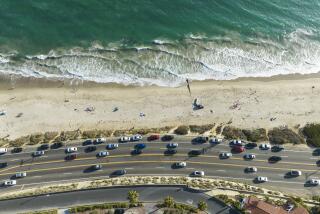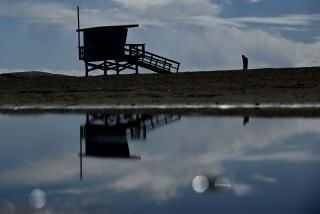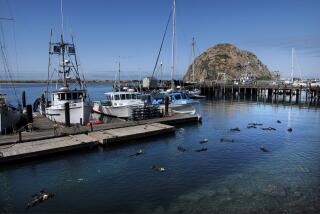Finally, a Clue in Huge Huntington Spill
As Orange County health officials reopened a portion of the Huntington Beach shoreline Monday, experts said they believe they found a clue that pinpoints a nearby channel as a potential source of the mysterious sewage leak.
After spending $400,000 on high-tech sleuthing over the past two months, experts put two cases of grapefruits and oranges--70 in all--into the Talbert Channel and then watched.
The fruit floated into the ocean and bobbed along currents into the same area where a sewage plume was first discovered at Huntington State Beach near Newland Street--the area still showing the highest level of bacteria.
Officials hope the results will allow them to focus on the channel, said Michelle Tuchman, an Orange County Sanitation District spokeswoman.
“The test at least helped us identify the flow pattern coming down from Talbert Channel, and it tells us that anything floating from there does indeed come [to the Newland area],” Tuchman said.
Scientists also spent the day taking bacteria and nutrient samples from the channel and the ocean. Results will not be available for a few days but should help determine whether the channel is the culprit, said Burt Jones, a USC associate professor of biology working with the sanitation district.
A drop in bacteria levels Monday at the northern edge of the 4.2-mile length of closed beach allowed officials to reopen nearly half a mile of shoreline to swimming and other water activity. The area is between 10th and Goldenwest streets.
But more than 3 1/2 miles of shoreline, from 10th Street south to the Santa Ana River, remain closed as a task force of local, state and federal officials look for a cause.
With Labor Day weekend fast approaching, county health officials said they are looking at test data to determine whether more areas can be reopened and a safe buffer still maintained to protect the public’s health.
“We are looking at whether the area north of [Huntington Beach] pier should be opened, provided the data supports that the public’s health comes first,” said Larry Honeybourne, chief of the Water Quality Section of the county Health Care Agency.
Also, health officials have changed ocean tests from every 24 hours to every 12 hours and from five days a week to seven, he said.
The only beach areas where bacteria levels have gone down were north of the pier, Honeybourne said. Levels are still high south of the pier, especially at Huntington State Beach near Newland Street.
The fruit launch, suggested by the National Oceanic and Atmospheric Administration, is aimed at better pinpointing the featherlike flow of water from what could be the source of contamination.
“This helps us follow the path of the water--that is, to check the ocean currents by following the floating fruit,” Tuchman said.
For more than a week, experts have focused on Talbert Channel, a concrete-lined culvert that fills with urban runoff. The channel empties into the Talbert marsh and then enters the ocean just north of the Santa Ana River, which borders Newport and Huntington Beach.
Three city-owned pumping stations that push storm water and urban runoff into Talbert Channel could be possible sources of the contamination, said Michael Moore, a sanitation district official.
In the past, oranges and grapefruits have been used as tracers of oil spills. The fruit partly sinks and is unaffected by wind. Scientists assume that the path of the fruit follows the path of the current.
Meanwhile, a Coast Guard helicopter with an environmental investigator on board took aerial photographs seeking to pinpoint the sewage plume. Instead, toxic algae known as red tide was floating in the water; it blocks the view into the water and hinders detection of other matter.
“We were looking for any type of plumage,” said the investigator, Kip Kinnings. “But one of the problems is that there’s a red tide that is complicating what we’re doing.”
The Surfrider Foundation, a San Clemente-based nonprofit coastal preservation group, said the incident highlights a need for a national water quality program.
“It was water quality testing that caught this,” said Chris Evans, Surfrider’s executive director. “From our perspective, it really highlights the importance of national water quality and testing.”
Surfrider supports the effort to locate the source of the sewage and intends to “take a really hard look at any failures in infrastructure” that may have caused the leak.
(BEGIN TEXT OF INFOBOX / INFOGRAPHIC)
Bobbing for Answers
A bit of low-tech sleuthing--watching grapefruits bob out of a channel into the ocean--may help experts get closer to the source of the contamination that has closed 4.2 miles of the Huntington Beach shoreline. Officials, meanwhile, were able to reopen a half-mile of beach Monday.
Source: Orange County Sanitation District
More to Read
Sign up for Essential California
The most important California stories and recommendations in your inbox every morning.
You may occasionally receive promotional content from the Los Angeles Times.










